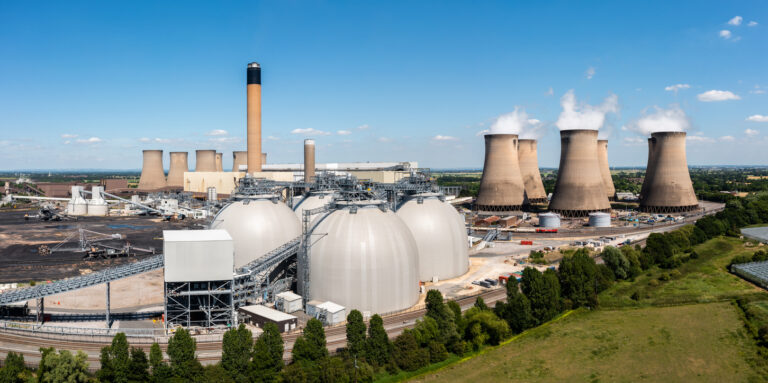Geological carbon removal: is the UK ready to lead?

The UK has too often failed to capitalise on the opportunities presented by emerging high-innovation, high-productivity sectors – it should ensure it avoids doing the same with carbon removals, writes Josh Burke.
Alongside rapidly reducing the amount of emissions reaching the atmosphere, existing and future carbon dioxide (CO2) will need to be removed to meet global climate goals. Scaling up carbon dioxide removal (CDR) is a critical challenge, but it could also represent a significant opportunity for the countries that innovate and build competitive supply chains for relevant technologies.
With policymakers increasingly placing economic growth at the centre of discussions on ambitious climate policy, demonstrating that investing in CDR can be growth-inducing may convince them of the benefits of providing greater public-sector support to the sector.
Robust estimates of the size of the future economic opportunity from CDR are hard to come by, but recent grey literature suggests it could be large. Some upper-bound estimates suggest the global market for CDR could reach US$100 billion a year between 2030 and 2035 (from US$2.7 billion in 2023), and up to US$1.2 trillion by 2050. Most of the estimated future value lies in two methods: BECCS (bioenergy with carbon capture and storage) and DACCS (direct air carbon capture and storage). These are not trivial figures. They suggest the emergence of a major new industrial sector.
But it is worth pointing out that their deployment (alongside other methods) will always incur an additional resource cost relative to not deploying these methods. This contrasts with modular and scalable renewables, which can produce energy more cheaply than alternatives. But the presence of a carbon market, together with the necessity to remove carbon to stabilise the climate and achieve net negativity, can theoretically make them very profitable.
Jurisdictions such as the EU and the UK have developed policy positions that recognise the ways that CDR can retain industrial competitiveness and thus benefit their economies. At the same time, early frontrunners in the emerging CDR economy – such as the US – may be squandering their competitive edge, spurring companies to move to less capricious policy environments.
So, is the UK ready to fill the void? And, critically, should it? David Sainsbury’s capability/market opportunity dynamic provides a framework for identifying sectors where a country can gain global advantage by aligning its strengths with high-growth opportunities and can help us answer these questions.
The capability: where does the UK have innovative specialism?
Sainsbury’s framework starts with capability: the existing scientific, industrial and institutional strengths a country can bring to bear.
On this front, the UK has much going for it with regard to BECCS and DACCS:
- Geological storage capacity: the UK’s North Sea assets offer some of the most abundant CO₂ storage sites in Europe, giving it a natural edge in geological CDR. This is essential for both DACCS and BECCS, which depend on safe, long-term carbon storage.
- Transferable expertise in adjacent industries such as CCS and subsurface engineering: decades of experience in oil and gas have created a deep talent base in offshore engineering, geology and infrastructure development – all highly transferable to CDR.
- Innovation in direct air capture: according to new research published by the Grantham Research Institute and the University of Oxford, between 2000 and 2020, the UK ranked sixth globally for the number of DAC (comprising of either capture/separation and regeneration but not carbon storage) relevant innovations and third in innovative specialism (i.e. the focus relative to other sectors). It excels particularly in direct air capture and separation technologies.
- Strong financial and carbon market ecosystem: this includes strengths in the development of carbon markets, having operated a domestic compliance market for over 20 years, a deep carbon market ecosystem consisting of market makers, ratings agencies and governance initiatives, and expertise in sustainable finance and commodity innovation.
- Policy alignment: the Government’s 2025 Industrial Strategy identifies carbon capture, usage and storage (CCUS), which includes BECCS and DACCS, as a frontier industry, with dedicated support mechanisms like the greenhouse gas removals business model nearing completion alongside the full operational integration of CDR into the UK Emissions Trading Scheme by end of 2029, putting the UK firmly at the front of the queue for compliance market integration. The upcoming independent review of CDR by Alan Whitehead is likely to re-affirm and provide additional political support.
The economic opportunity
The second half of Sainsbury’s framework is market opportunity: how large, global and strategic a sector is likely to become.
Here, the numbers are potentially significant. By 2030, engineered carbon removals (predominantly BECCS and DACCS) in the UK could create a US$500 million domestic market. By 2050, the global DAC market could reach £60 billion (~US$75 billion) annually. If the UK captures even 2% of that, it will generate £1 billion per year in revenue. This would not transform the British economy, but it would anchor a high-value, export-led clean technology sector.
CDR is not a niche – it’s a core pillar of net zero. As regulatory pressure builds on industries like aviation and cement, durable carbon removals will become as valuable as clean energy is today.
Where capability meets the economic opportunity
In Sainsbury’s terms, the UK’s position in DAC and geological storage lies squarely in the ‘high capability, high opportunity’ quadrant – exactly where governments should invest to lead.
The UK is already home to six DAC companies (the fourth largest number globally). It has robust intellectual property, world-class research institutions and a growing deployment pipeline. Policy support is now in place to help scale-up that capability.
With regard to BECC, the UK ranks eighth globally in the number of innovations between 2000 and 2020 – but lags behind in key areas like energy conversion efficiency, where France is more dominant.
Comparing innovative specialism across domestic UK sectors
Comparing the UK’s innovative specialism in DAC against other selected domestic sectors yields surprising results. The UK has a greater specialism in DAC than in any other clean tech sector except tidal energy, and more than in solar, nuclear or clean vehicles. In Europe, the UK is third for DAC innovation and second in DAC company presence, behind only Germany.
However, for the UK to realise the economic benefit of this innovation it must retain and reshore more of the economic spillovers. For example, the estimated domestic returns to public investment in BECC innovation in the UK is lower than countries including Germany and the Netherlands. It does better in DAC – ranking seventh globally in estimated returns – but still trails in capturing and retaining the full domestic economic benefits of its innovations.
This points to a broader problem in UK industrial policy: the failure to convert scientific leadership into commercial scale. Unless manufacturing, deployment and services remain anchored in the domestic economy, the UK will continue to innovate for the benefit of others.
This is not merely an economic concern. It is also a political one. Voters will not support ambitious climate spending if the rewards – jobs, growth, strategic advantage – are seen to accrue elsewhere.
Policy priorities: a Sainsbury lens
Historically, the UK has failed to capitalise on enough high-innovation, high-productivity sectors. Of the four possible strategies towards innovation – leave it to the market; support the supply of relevant factors of production (science and skilled people); support key industries and technologies; and pick specific firms/technologies/products – Sainsbury argues that governments should do the second and third.
Following this logic, to fully exploit the CDR opportunity this implies the UK should continue to invest in DAC and storage at scale, by funding R&D, pilot projects and CO₂ storage build-out, and it should support early commercial deployment through contracts-for-difference or public procurement.
Strengthening financial ecosystems and demand mechanisms should also continue at pace. The integration of BECCS and DACCS into the UK emissions trading system by 2029 could potentially create demand pull, should prices rise high enough. The UK should continue to develop the institutions able to support CDR companies, including leveraging the City of London’s financial leadership and ability to develop CDR-linked financial tools and global standards. Retaining domestic economic spillovers will be key to realising the economic potential of CDR.
Closing the value gap
According to Sainsbury’s framework, the UK’s position in DAC and geological carbon storage is a textbook example of where public and private investment should converge. The capabilities are real – from innovation to geology to finance – and the market opportunity is immense and global. Yet realising the economic value is a significant challenge, not least because DACCS can be heavy on the operating expenses and the UK is a higher-cost location for deployment than some other locations globally due to its high energy prices. And factoring in the UK’s chequered history in developing capital-intensive infrastructure projects (HS2 and Sizewell C nuclear plant are cautionary tales) there are reasons to doubt.
However, to fixate on these risks is to miss the point. The UK does not need to dominate the entire CDR value chain. It needs to lead in niches where it has comparative advantage: high-value DAC innovation, carbon finance and North Sea storage. These are difficult to imitate and strategically vital.
The alternative is to allow this sector – like so many others – to flourish elsewhere, with Britain consigned once again to the role of importer rather than exporter. But with the right policies, appropriate planning reforms, investments and industry alignment, the UK could turn its current strengths into long-term leadership.
A version of this commentary was first published by Business Green on 25 July and has been reproduced here with permission.

